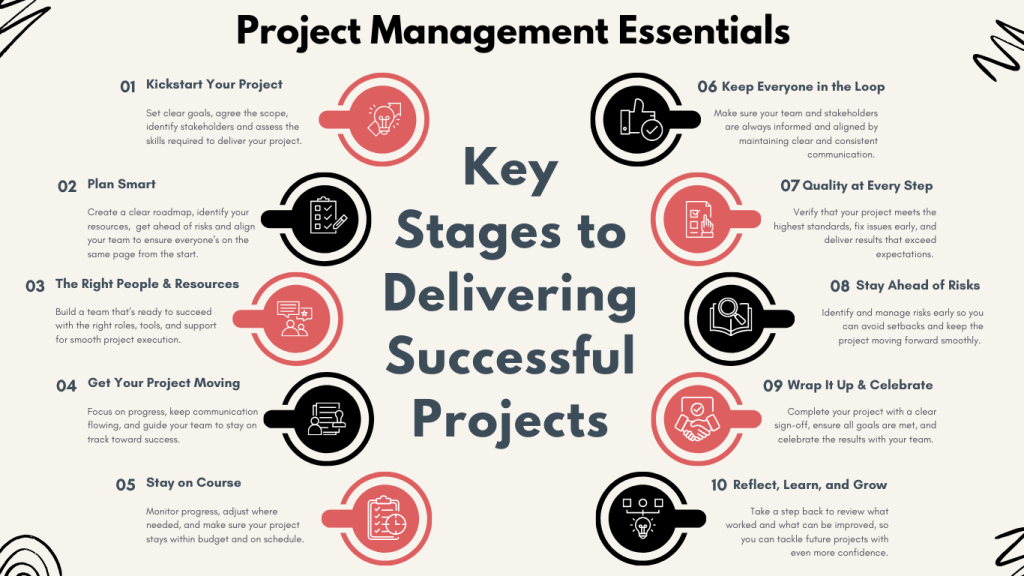The Key Stages for Delivering Successful Projects
Our latest series, Project Management Essentials, is all about getting back to basics. Whether you’re a new project manager, a junior PM, or a seasoned project lead juggling multiple priorities, this is your quick refresher when things get hectic. Over the next few weeks, we’ll break down the key stages of project management helping you streamline your projects, improve efficiency, and keep things on track. Let’s dive in and set your project up for success!
The Quick Guide
Before we get into the details, here’s a high-level look at the key stages when delivering a project:

The Detailed Guide:
In this detailed guide, we’ll break down the key stages of the project management cycle and explore how each one sets the foundation for success. Let’s dive into the details and make managing projects feel less overwhelming and more empowering!
1. Initiation: Kickstart Your Project with a Strong Foundation
This is where it all begins—the stage that sets your project up for success. Here’s what to focus on:
- Set the Goal: Define what success looks like and make sure everyone’s in agreement.
- Agree Scope: Define what’s in scope (and what’s not) and make sure everyone’s aligned.
- Resources: Assess the skills required, match the right resources and check availability.
- Who’s Who?: Identify stakeholders, understand their priorities, and keep them in the loop.
When you get this phase right, you’re not just starting—you’re setting the tone for a project that’s built to succeed..
2. Planning: Plan Smart, Design with Confidence
This is where your ideas take shape and your project gets its structure. Focus on:
- Build Your Roadmap: Lay the steps and milestones that will guide your team throughout
- Agree Resources: Know who you need, check their capacity and get them booked.
- Clear Roles: Agree responsibilities and how the team contributes to the big picture.
- The Right Tools: Set your team up with the tools and resources they need.
- Risks: Spot potential issues early and have a plan to tackle them.
- The Detail: Define timelines, dependencies, and priorities to ensure smooth delivery.
- Set the Bar: Define clear standards upfront so everyone knows what “good” looks like.
- Bring the Team Together: Align everyone with a briefing document or kick-off meeting.
- Collaboration: Create an environment where communication and teamwork can thrive.
A solid plan doesn’t just guide your team—it sets the stage for a project that’s on track and stress-free.
3. Execution: Turning Plans into Action
Now it’s time to bring your project to life. Whether you’re working in sprints or a phased approach, keep things moving by focusing on:
- Planning: Set priorities and ensure teams stay focused.
- Communication: Stand-ups, check-ins, and updates keep everyone aligned.
- Testing: Test early and often to catch issues early.
- Refine: Address feedback and fine-tune deliverables to exceed expectations.
- Support: Remove issues, provide clarity, and engage the team to maintain productivity.
- Adapt & Iterate: Be flexible where possible and adjust priorities as needed.
Execution is all about turning effort into results—keep the energy up, adjust as needed, and guide your team toward success!
4. Monitoring: Stay on Course & Keep It Moving
Throughout delivery, there are key tasks you need to stay on top of to keep your project running smoothly. I like to schedule these in my diary from day one—because once things get hectic, it’s easy for priorities to slip! These tasks help you stay in control and keep everything on track. Focus on:
- Track Progress: Check in on timelines, budgets, and milestones to spot issues early.
- Plan and Adjust: Review and adapt plans as things progress.
- Cost Review: Keep a close eye on the budget and manage resources wisely.
- Risk Analysis: Address risks and roadblocks before they escalate.
- Reporting: Share status reports showing progress, planned activities and any risks needing stakeholder support
By staying in control, you’ll keep the project moving smoothly toward its goals.
5. Closing: Wrap It Up & Celebrate Success
The finish line is in sight—this is where it all comes together:
- Confirm the Goals: Ensure every deliverable meets the agreed standards and objectives.
- Get That Sign-Off: Secure approval from stakeholders to officially wrap things up.
- Celebrate the Wins: Acknowledge the team’s efforts and celebrate the success you’ve achieved together.
Closing isn’t just about ending the project—it’s about ending it well.
6. Post-Project Review: Reflect, Learn, and Grow for Next Time
The project’s done, but the learning never stops:
- What Went Well? Celebrate successes and identify what made them possible.
- Improvements: Reflect on challenges and uncover opportunities to do better next time.
- Document &: Capture those insights and share with the team
- Take Forward: Use these lessons to build a stronger foundation for future projects.
Reflection isn’t just about looking back—it’s about using those lessons to move forward with confidence.
That’s a wrap for part one! Keep in mind that not every element will fit every project, and that’s okay. Pick what works for you and your project. For now, focus on what truly matters, and know I’m here rooting for you every step of the way. You’ve got this!
Want more? Stick around!
Over the next few weeks, I’ll be diving deeper into each stage of the project journey, sharing practical tips to help you stay on track and deliver with confidence. Stay tuned!
